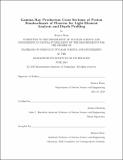| dc.contributor.advisor | Zachary Hartwig. | en_US |
| dc.contributor.author | Pham, Monica. | en_US |
| dc.contributor.other | Massachusetts Institute of Technology. Department of Nuclear Science and Engineering. | en_US |
| dc.date.accessioned | 2019-11-12T18:12:54Z | |
| dc.date.available | 2019-11-12T18:12:54Z | |
| dc.date.copyright | 2019 | en_US |
| dc.date.issued | 2019 | en_US |
| dc.identifier.uri | https://hdl.handle.net/1721.1/122908 | |
| dc.description | This electronic version was submitted by the student author. The certified thesis is available in the Institute Archives and Special Collections. | en_US |
| dc.description | Thesis: S.B., Massachusetts Institute of Technology, Department of Nuclear Science and Engineering, 2019 | en_US |
| dc.description | Cataloged from student-submitted PDF version of thesis. | en_US |
| dc.description | Includes bibliographical references (pages 42-43). | en_US |
| dc.description.abstract | Due to the interdependence of fusion reactor performance and the surface conditions of the plasma facing components (PFC), diagnostic techniques that monitor the conditions of PFCs are useful. One ion beam analysis (IBA) diagnostic technique utilizes particle induced gamma emission (PIGE) analysis to diagnose the conditions of PFCs. Gamma production differential cross section data is essential to PIGE because it provides a way predict and interpret data. Fluorine may be a candidate for this technique because it is low-Z and not typically intrinsic to fusion reactors. However, differential cross section measurements for 19F(p, [alpha] [gamma])16O do not exist yet. Differential cross section measurements for the 19F(p, [alpha] [gamma])16O reaction have not been measured primarily because of the difficulty of deconvolving overlapped peaks in the gamma ray spectra of the reaction. This work presents, for the first time, the 6.13 MeV gamma production differential cross section for the 19F(p, [alpha] [gamma])16O reaction in the 840 to 1520 keV energy range. Although there exists gamma yield data for this reaction in Dababneh et al. [1], yield measurements can only be used as a comparison or for relative measurements. Additionally, previous yield measurements relied on integrating the entire spectrum with approximate bounds of 4.5 to 9 MeV likely due to overlap of peaks. In this work, yield of the 6.13 MeV full energy peak was obtained by deconvolving overlapping peaks by utilizing the constant ratio of the double escape and the single escape peaks. The subsequent yield curve was converted to differential cross section. The presented differential cross section measurements expands current knowledge and contributes to diagnostic techniques that utilize gamma production reactions. | en_US |
| dc.description.statementofresponsibility | by Monica Pham. | en_US |
| dc.format.extent | 77 pages | en_US |
| dc.language.iso | eng | en_US |
| dc.publisher | Massachusetts Institute of Technology | en_US |
| dc.rights | MIT theses are protected by copyright. They may be viewed, downloaded, or printed from this source but further reproduction or distribution in any format is prohibited without written permission. | en_US |
| dc.rights.uri | http://dspace.mit.edu/handle/1721.1/7582 | en_US |
| dc.subject | Nuclear Science and Engineering. | en_US |
| dc.title | Gamma ray production cross sections of proton bombardment of fluorine for light element analysis and depth profiling | en_US |
| dc.type | Thesis | en_US |
| dc.description.degree | S.B. | en_US |
| dc.contributor.department | Massachusetts Institute of Technology. Department of Nuclear Science and Engineering | en_US |
| dc.identifier.oclc | 1126284392 | en_US |
| dc.description.collection | S.B. Massachusetts Institute of Technology, Department of Nuclear Science and Engineering | en_US |
| dspace.imported | 2019-11-12T18:12:53Z | en_US |
| mit.thesis.degree | Bachelor | en_US |
| mit.thesis.department | NucEng | en_US |

